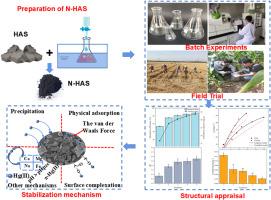改性煤基腐植酸渣稳定废水和土壤中汞的研究
IF 7.3
2区 环境科学与生态学
Q1 ENVIRONMENTAL SCIENCES
引用次数: 0
摘要
煤基腐植酸渣(HAS)作为腐植酸生产过程中产生的废弃物,由于其吸附能力和含有的营养成分,近年来备受关注。为了提高HAS对汞的吸附能力,采用水热法制备了磷酸盐修饰材料(N -HAS),并采用扫描电镜(SEM)、傅里叶变换红外光谱(FTIR)、X -射线荧光(XRF)对其进行了表征;间歇吸附实验考察了不同pH下N - HAS对Hg2+的吸附能力,采用等温吸附模型和动力学模型拟合吸附过程,探讨吸附机理;通过田间试验研究了不同N - HAS处理对汞污染土壤下玉米体内汞含量和土壤有效汞含量的影响。结果表明:拟二级动力学模型(R2=0.9641)和Langmuir等温吸附模型(R2=0.95)能较好地描述N - HAR对Hg2+的吸附行为,N - HAS的最大吸附量为124.20 mg/g,达到吸附平衡的时间较HAS短;经过5次吸附-解吸后,N - HAS对Hg2+的去除率仍大于80%,循环吸附性能稳定;N - HAS吸附Hg2+的机理包括物理吸附、沉淀和表面络合,与HAS相比,N - HAS吸附Hg2+的络合率提高了77.81%,沉淀率提高了7.68%;与对照组相比,N - HAS的添加显著降低了(p <;0.05)使玉米籽粒汞含量提高27.44% ~ 72.09%,生物量提高4.34% ~ 11.26%,土壤有效汞含量降低50.00% ~ 82.80%。此外,在田间试验中,以0.4 kg/m2的N - HAS添加量为最佳。研究表明,N - HAS不仅实现了资源利用,而且对水体和土壤中的Hg2+具有很大的处理潜力。本文章由计算机程序翻译,如有差异,请以英文原文为准。

Study on stabilization of mercury in wastewater and soil by modified coal-based humic acid residue
Coal-based humic acid residue (HAS), as a waste generated during humic acid production, has been gaining attention in recent years due to its adsorption capacity and containing nutrients. In this study, to improve the adsorption capacity of HAS for and Hg, phosphate-modified materials (N−HAS) were prepared by a hydrothermal method and HAS and N-HAS were characterized by scanning electron microscopy (SEM), Fourier transforms infrared spectroscopy (FTIR), X−ray fluorescence (XRF); batch adsorption experiments investigated the adsorption capacity of N−HAS on Hg2+ under different pH, and isothermal adsorption model and kinetic model fitted the adsorption process to explore the adsorption mechanism; the effects of various amounts of N−HAS on the Hg content in maize and the effective Hg in the soil under Hg−contaminated soil were investigated by field trial. The results showed that the pseudo−second−order kinetic model (R2=0.9641) and Langmuir isothermal (R2=0.95) adsorption model could better describe the adsorption behavior of N−HAR on Hg2+, the maximum adsorption amount was 124.20 mg/g, and the time to reach adsorption equilibrium was shorter for N−HAS compared to HAS; after 5 times of adsorption−desorption, the removal rate of Hg2+ by N−HAS was still higher than 80%, with stable cyclic adsorption performance; the adsorption mechanism of Hg2+ by N−HAS included physical adsorption, precipitation, and surface complexation, and compared with HAS, the percentage of complexation for Hg2+ adsorption by N−HAS increased by 77.81%, and the percentage of precipitation increased by 7.68%; compared to the control group, it was shown that the addition of N−HAS significantly decreased (p < 0.05) the Hg content of maize kernels by 27.44% ∼ 72.09%, increased biomass by 4.34% ∼ 11.26%, and decreased the available Hg content in soil by 50.00% ∼ 82.80%. In addition, the addition of N−HAS at 0.4 kg/m2 was optimal for the field trial. The study showed that N−HAS not only achieved resource utilization but also demonstrated great potential for treating Hg2+ in water and soil.
求助全文
通过发布文献求助,成功后即可免费获取论文全文。
去求助
来源期刊

Environmental Pollution
环境科学-环境科学
CiteScore
16.00
自引率
6.70%
发文量
2082
审稿时长
2.9 months
期刊介绍:
Environmental Pollution is an international peer-reviewed journal that publishes high-quality research papers and review articles covering all aspects of environmental pollution and its impacts on ecosystems and human health.
Subject areas include, but are not limited to:
• Sources and occurrences of pollutants that are clearly defined and measured in environmental compartments, food and food-related items, and human bodies;
• Interlinks between contaminant exposure and biological, ecological, and human health effects, including those of climate change;
• Contaminants of emerging concerns (including but not limited to antibiotic resistant microorganisms or genes, microplastics/nanoplastics, electronic wastes, light, and noise) and/or their biological, ecological, or human health effects;
• Laboratory and field studies on the remediation/mitigation of environmental pollution via new techniques and with clear links to biological, ecological, or human health effects;
• Modeling of pollution processes, patterns, or trends that is of clear environmental and/or human health interest;
• New techniques that measure and examine environmental occurrences, transport, behavior, and effects of pollutants within the environment or the laboratory, provided that they can be clearly used to address problems within regional or global environmental compartments.
 求助内容:
求助内容: 应助结果提醒方式:
应助结果提醒方式:


